Themed collection Spotlight Collection: MOF Sensors

The impact of MOFs in pH-dependent drug delivery systems: progress in the last decade
Zn based MOFs, MIL series MOFs, and Zr-based MOFs - Three different pH-responsive drug delivery systems for cancer therapy.
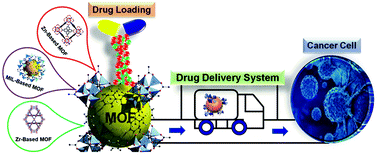
Dalton Trans., 2022,51, 9950-9965
https://doi.org/10.1039/D2DT00994C
Flexible luminescent non-lanthanide metal–organic frameworks as small molecules sensors
Non-lanthanide metal–organic frameworks with flexible structure and luminescence properties are systematically discussed as potential small molecule sensors.
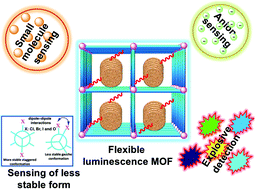
Dalton Trans., 2021,50, 14513-14531
https://doi.org/10.1039/D1DT03175A
Two luminescent coordination polymers as highly selective and sensitive chemosensors for CrVI-anions in aqueous medium
Two luminescent coordination polymers with considerable stability in aqueous media were synthesized. Sensing experiments indicate that they can serve as highly selective and sensitive fluorescent probes toward CrVI-anions.
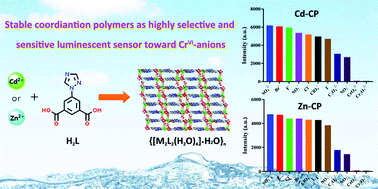
Dalton Trans., 2019,48, 387-394
https://doi.org/10.1039/C8DT04230F
Amine-substituent induced highly selective and rapid “turn-on” detection of carcinogenic 1,4-dioxane from purely aqueous and vapour phase with novel post-synthetically modified d10-MOFs
Amine-functionalized post-synthetically modified d10 MOFs for selective and rapid 'turn-on' recognition of carcinogenic 1,4-dioxane from aqueous medium and vapour phase

Dalton Trans., 2022,51, 2083-2093
https://doi.org/10.1039/D1DT03976H
Multicolour lanthanide(III) porous 1D coordination polymers: tunable wide spectrum emission and efficient CuII sensing
Five isostructural 1D porous coordination polymers (PCPs) with a general formula of {[M(L)(DMF)(H2O)]·1.5H2O}n [M = TbIII (1), EuIII (2), YbIII (3), NdIII (4) and ErIII (5)] have been synthesized using a flexible tripodal organic linker (L) and characterized.
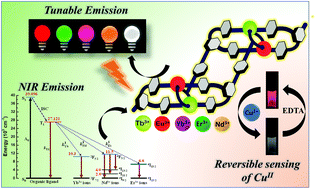
Dalton Trans., 2021,50, 13002-13011
https://doi.org/10.1039/D1DT01860D
A luminescent cationic MOF for bimodal recognition of chromium and arsenic based oxo-anions in water
Selective bimodal “turn off/on” response in a water stable cationic MOF toward toxic water pollutants (CrO42−, Cr2O72−, HAsO42−, and HAsO32−).
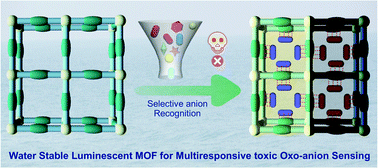
Dalton Trans., 2021,50, 10133-10141
https://doi.org/10.1039/D1DT01097B
First Ln-MOF as a trifunctional luminescent probe for the efficient sensing of aspartic acid, Fe3+ and DMSO
The first Ln-MOF (Tb-MOF) as a trifunctional luminescent probe for the efficient sensing of aspartic acid, Fe3+ and DMSO was demonstrated.
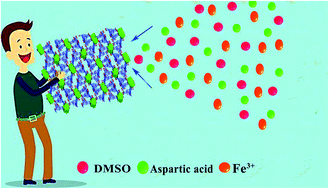
Dalton Trans., 2020,49, 7514-7524
https://doi.org/10.1039/D0DT00938E
Two luminescent lanthanide(III) metal–organic frameworks as chemosensors for high-efficiency recognition of Cr(VI) anions in aqueous solution
Two 12-connected sqc15 lanthanide(III) MOFs act as luminescent turn-off chemosensors for high-efficiency recognition of Cr2O72− and CrO42− anions in aqueous solution.
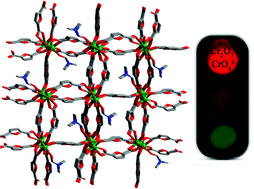
Dalton Trans., 2018,47, 15694-15702
https://doi.org/10.1039/C8DT03050B
Rational synthesis of a luminescent uncommon (3,4,6)-c connected Zn(II) MOF: a dual channel sensor for the detection of nitroaromatics and ferric ions
A 3D (3,4,6)-c connected net constructed using a rigid tetracarboxylate ligand and sensing studies to detect nitroaromatics and ferric ion performed.
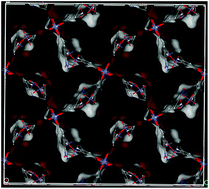
Dalton Trans., 2018,47, 9627-9633
https://doi.org/10.1039/C8DT01923A
Lanthanide hybrids of covalently-coordination cooperative post-functionalized metal–organic frameworks for luminescence tuning and highly-selectively sensing of tetrahydrofuran
Lanthanide based MOFs are synthesized through covalently-coordination cooperative post-functionalization, and exhibit multi-color luminescence and highly-selectively sensing of THF.
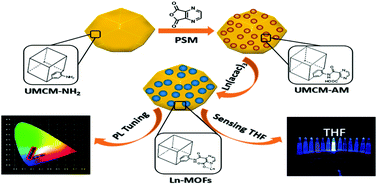
Dalton Trans., 2018,47, 6210-6217
https://doi.org/10.1039/C8DT00551F
From 2D → 3D interpenetration to packing: N coligand-driven structural assembly and tuning of luminescent sensing activities towards Fe3+ and Cr2O72− ions
Three complexes were hydrothermally synthesized and exhibited excellent selectivity towards Fe3+ and Cr2O72−.
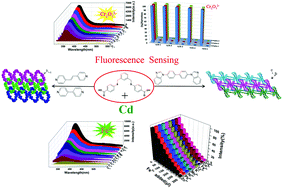
Dalton Trans., 2018,47, 6240-6249
https://doi.org/10.1039/C8DT00909K
Engineering design toward exploring the functional group substitution in 1D channels of Zn–organic frameworks upon nitro explosives and antibiotics detection
Three MOFs (1, 2, 3) with distinct functional groups were prepared. 2 exhibited moderate sensitivity for the detection of specific explosives/antibiotics at the same concentration, which was lower and higher than that of 3 and 1, respectively.

Dalton Trans., 2018,47, 5359-5365
https://doi.org/10.1039/C8DT00594J
Highly selective sensing of Fe3+ by an anionic metal–organic framework containing uncoordinated nitrogen and carboxylate oxygen sites
An anionic metal–organic framework containing uncoordinated nitrogen and carboxylate oxygen sites for highly selective and sensitive sensing of Fe3+.
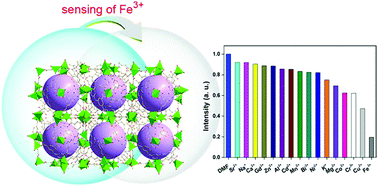
Dalton Trans., 2018,47, 3452-3458
https://doi.org/10.1039/C8DT00088C
Extraordinary sensitivity for H2S and Fe(III) sensing in aqueous medium by Al-MIL-53-N3 metal–organic framework: in vitro and in vivo applications of H2S sensing
An Al-MIL-53-N3 MOF sensor showing extraordinary sensitivity for H2S and Fe(III) is presented. Its cell imaging capability is also demonstrated.
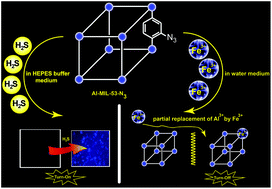
Dalton Trans., 2018,47, 2690-2700
https://doi.org/10.1039/C7DT04009A
The effect of functional groups in the aqueous-phase selective sensing of Fe(III) ions by thienothiophene-based zirconium metal–organic frameworks and the design of molecular logic gates
The effect of functional groups in the fluorescence sensing of Fe(III) ions in aqueous medium by four thienothiophene-based Zr MOFs is discussed.
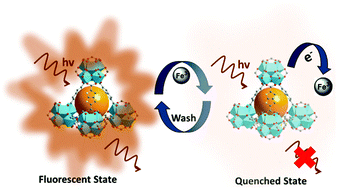
Dalton Trans., 2018,47, 1159-1170
https://doi.org/10.1039/C7DT04130F
Assembly of a series of coordination polymers built from rigid a tetracarboxylate ligand and flexible bis(imidazole) linker: syntheses, structural diversities, luminescence sensing, and photocatalytic properties
CPs have been constructed from the reaction of terphenyl-4,2′′,5′′,4′-tetracarboxylic acid and two different bis(imidazole) bridging linkers under hydrothermal conditions.
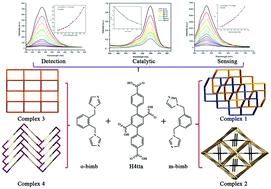
Dalton Trans., 2018,47, 1202-1213
https://doi.org/10.1039/C7DT03761A
About this collection
Metal-organic frameworks (MOFs), comprised of metal ions and bridging organic ligands, have emerged as an important family of porous materials. Owing to their highly porous structures with functional properties, MOFs are considered as one of the most ideal materials for chemical sensors as the sensing properties are strongly influenced by surface interaction between analyte molecules and pore walls of MOFs. The application of MOFs covers the fields of sensing toward a variety of target compounds, including gases, solvents, explosives, ions, pollutions, and biological molecules. This spotlight collection focuses on the latest studies on MOF-based sensors published in Dalton Transactions, showing highly sensitive detections and the future research directions using MOFs with respect to general sensing principles and analytical performance.
This collection is guest edited by Dalton Transactions Associate Editor Takashi Uemura (University of Tokyo).
Articles will be added to this themed collection as soon as possible after they are published. Please return to this page frequently to see the collection grow.
If you would like to contribute an article to this collection, please contact the Editorial Office at dalton-rsc@rsc.org with your proposed topic.